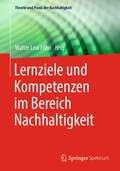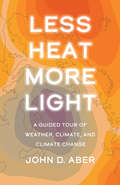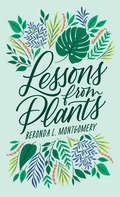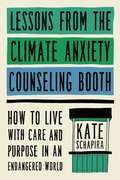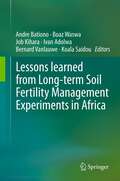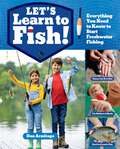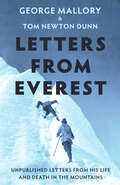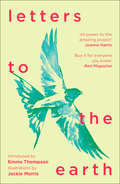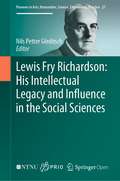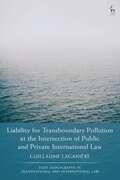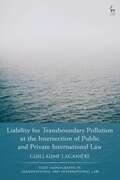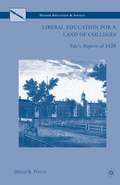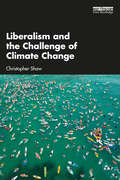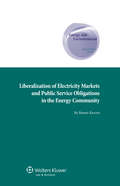- Table View
- List View
Leonardo's Mountain Of Clams: Essays On Natural History (Drakontos Ser.)
by Stephen Jay GouldStephen Jay Gould's writing remains the modern standard by which popular science writing is judged. Ever since the last 1970s, his monthly essay in Natural History and his full-length books have bridged the yawning gap between science and the wider culture. This fascinating new collection of essays contains some of Gould's bestw riting on a variety of subjects ranging from Leonardo da Vinci and Martin Luther to fossils and the history of science. As always, these essays brillantly display his gift for colloquial and vivid explanation, and include fascinating oddities from the natural world and the printed word.
Leonid Isaakovich Mandelstam: Research, Teaching, Life
by Alexander PechenkinThis biography of the famous Soviet physicist Leonid Isaakovich Mandelstam (1889-1944), who became a Professor at Moscow State University in 1925, describes his contributions to both physics and technology, as well as discussing the scientific community which formed around him, usually called the Mandelstam school. Mandelstam’s life story is thereby placed in its proper cultural context. The following more general issues are taken under consideration: the impact of German scientific culture on Russian science; the problems and fates of Russian intellectuals during the revolutionary and post-revolutionary years; the formation of the Soviet Academy of Sciences; and transformation of the system of higher education in the USSR during the 1920's and 1930's.The author shows that Mandelstam’s fundamental writings and his lectures notes allow to reconstruct his philosophy of science and his approach to the social and ethical functions of science and science education. That reconstruction is enhanced through extensive use of hitherto unpublished archival material as well as the transcripts of personal interviews conducted by the author.
Lernziele und Kompetenzen im Bereich Nachhaltigkeit (Theorie und Praxis der Nachhaltigkeit)
by Walter Leal FilhoDas Buch zeigt Ihnen, wie sich Lernziele und Kompetenzen im Bereich Nachhaltigkeit ergänzen und hilft, die komplexe und vernetzte Natur der Nachhaltigkeit besser zu verstehen, und die damit verbundenen Herausforderungen zu erkennen und anzugehen. Dazu gehört auch die Vermittlung von Kenntnissen über die verschiedenen Aspekte der Nachhaltigkeit, wie z. B. ökologische, soziale und wirtschaftliche Aspekte, sowie deren Wechselwirkung miteinander. Darüber hinaus zeigt das Buch auf, wie Sie die möglichen Auswirkungen von Entscheidungen und Maßnahmen auf die Nachhaltigkeit einschätzen und bewerten können. Das Buch beschreibt die Zusammenhänge zwischen Nachhaltigkeit und Lernen. Es wird erörtert, wie Bildung und Lernen im Bereich der Nachhaltigkeit uns helfen können, die natürliche Welt und unsere Beziehung zu ihr zu verstehen und bessere Entscheidungen zu treffen, um unser Leben und die Umwelt zu verbessern. Es untersucht auch die Rolle von Technologie und Bildung im Bereich der Nachhaltigkeit und erkundet, wie Nachhaltigkeit in den Unterricht und das Lernen integriert werden kann. Schließlich enthält das Buch praktische Ratschläge zur Schaffung eines nachhaltigen Lernumfelds und zur Anwendung von Nachhaltigkeit in der Hochschulbildung und in den unteren Bildungsstufen.
Less Heat, More Light: A Guided Tour of Weather, Climate, and Climate Change
by John D. AberA straightforward and fact-based exploration of how weather happens, how it relates to climate, and how science answers major questions about Earth as a system Climate change is one of the most hotly contested environmental topics of our day. To answer criticisms and synthesize available information, scientists have been driven to devise increasingly complex models of the climate system. This book conveys that the basics of climate and climate change have been known for decades, and that relatively simple descriptions can capture the major features of the climate system and help the general public understand what controls climate and weather, and how both might be changing. Renowned environmental scientist and educator John D. Aber distills what he has learned from a long fascination with weather and climate, the process of science, and the telling of the story of science. This is not a book about policies and politics. Instead, it explores how weather happens, how it relates to climate, and how science has been used to answer major questions about the Earth as a system and inform policies that have reversed environmental degradation. By providing a guided tour of the science of weather, this thoughtful survey will contribute clarity and rationality to the public understanding of climate change.
Less is More: How Degrowth Will Save the World
by Jason Hickel______________________'A powerfully disruptive book for disrupted times ... If you're looking for transformative ideas, this book is for you.' KATE RAWORTH, economist and author of Doughnut Economics______________________The world has finally awoken to the reality of climate breakdown and ecological collapse. Now we must face up to its primary cause. Capitalism demands perpetual expansion, which is devastating the living world. There is only one solution that will lead to meaningful and immediate change: DEGROWTH.If we want to have a shot at halting the crisis, we need to restore the balance. We need to change how we see nature and our place in it, shifting from a philosophy of domination and extraction to one that's rooted in reciprocity and regeneration. We need to evolve beyond the dogmas of capitalism to a new system that is fit for the twenty-first century. But what does such a society look like? What about jobs? What about health? What about progress?This book tackles these questions and traces a clear pathway to a post-capitalist economy. An economy that's more just, more caring, and more fun. An economy that enables human flourishing while reversing ecological breakdown. An economy that will not only lift us out of our current crisis, but restore our sense of connection to a world that's brimming with life. By taking less, we can become more.______________________'A masterpiece... Less is More covers centuries and continents, spans academic disciplines, and connects contemporary and ancient events in a way which cannot be put down until it's finished.' DANNY DORLING, Professor of Geography, University of Oxford'Jason is able to personalise the global and swarm the mind in the way that insects used to in abundance but soon shan't unless we are able to heed his beautifully rendered warning.' RUSSELL BRAND'Jason Hickel shows that recovering the commons and decolonizing nature, cultures, and humanity are necessary conditions for hope of a common future in our common home.' VANDANA SHIVA, author of Making Peace With the Earth'This is a book we have all been waiting for. Jason Hickel dispels ecomodernist fantasies of "green growth". Only degrowth can avoid climate breakdown. The facts are indisputable and they are in this book.' GIORGIS KALLIS, author of Degrowth'Capitalism has robbed us of our ability to even imagine something different; Less is More gives us the ability to not only dream of another world, but also the tools by which we can make that vision real.' ASAD REHMAN, director of War on Want'One of the most important books I have read ... does something extremely rare: it outlines a clear path to a sustainable future for all.' RAOUL MARTINEZ, author of Creating Freedom'Jason Hickel takes us on a profound journey through the last 500 years of capitalism and into the current crisis of ecological collapse. Less is More is required reading for anyone interested in what it means to live in the Anthropocene, and what we can do about it.' ALNOOR LADHA, co-founder of The Rules
The Less Is More Garden: Big Ideas for Designing Your Small Yard
by Susan MorrisonWith practical tips and high-end design ideas, The Less is More Garden can help you turn your small backyard into a unique space that is lovely to look at, family-friendly, and low maintenance.
Lesser Flamingos: Descendants of Phoenix
by Lothar KrienitzThis book provides insights into the fascinating life of the Lesser Flamingo (Phoeniconaias minor) and describes how this enigmatic bird has adapted to the extreme conditions of tropical soda lakes and can even withstand the caustic effects of brine. However, humans are increasingly disrupting the natural cycles of these wetlands, and for these pink birds characteristic of these salt lakes, it is becoming more and more difficult to find suitable habitats, food and breeding grounds. Their fate is considered a cautionary example of man’s dealings with nature. Will the Lesser Flamingo survive in a man-made world?Flamingos are considered to be an embodiment of the Phoenix, and the author interweaves his personal experiences with and observations of the flamingos’ unusual habitats with the Phoenix motif in order to stimulate reflection on the circle of life. Written in an accessible style that combines science, biological information and the author’s own travels and fieldwork, the book also includes a wealth of captivating images. As such, it offers a unique resource for biologists and nature-loving Africa and Asia enthusiasts alike.
Lessons for Climate Change Adaptation from Better Management of Rivers (Climate and Development Series)
by Jamie PittockClimate change is dramatically affecting freshwater supplies, particularly in the developing world. The papers in this volume present a powerful case for and exploration of different freshwater adaptation strategies in the face of global climatic change. The volume centres on six detailed case studies, from India, China, Mexico, Brazil, the lower Danube basin and Tanzania, written by experienced local academics and practitioners. They assess autonomous adaptation in the freshwater sector, drawing out key lessons about what motivated these societies to change, which factors led to more successful adaptation, and how interventions may best be sustained. The volume also contains a global overview of the lessons derived from these experiences. It sheds light on two key theories: that vulnerability to climate change is best reduced by reducing poverty and promoting sustainable development first, or by reducing bio-physical risks from climate change. The publication also highlights the need to ensure that access to more precise climate change impact data is not used as an excuse to delay implementation of no regrets adaptation measures.
Lessons for Climate Change Adaptation from Better Management of Rivers (Climate and Development Series)
by Jamie PittockClimate change is dramatically affecting freshwater supplies, particularly in the developing world. The papers in this volume present a powerful case for and exploration of different freshwater adaptation strategies in the face of global climatic change. The volume centres on six detailed case studies, from India, China, Mexico, Brazil, the lower Danube basin and Tanzania, written by experienced local academics and practitioners. They assess autonomous adaptation in the freshwater sector, drawing out key lessons about what motivated these societies to change, which factors led to more successful adaptation, and how interventions may best be sustained. The volume also contains a global overview of the lessons derived from these experiences. It sheds light on two key theories: that vulnerability to climate change is best reduced by reducing poverty and promoting sustainable development first, or by reducing bio-physical risks from climate change. The publication also highlights the need to ensure that access to more precise climate change impact data is not used as an excuse to delay implementation of no regrets adaptation measures.
Lessons from Plants
by Beronda L. MontgomeryAn exploration of how plant behavior and adaptation offer valuable insights for human thriving. We know that plants are important. They maintain the atmosphere by absorbing carbon dioxide and producing oxygen. They nourish other living organisms and supply psychological benefits to humans as well, improving our moods and beautifying the landscape around us. But plants don’t just passively provide. They also take action. Beronda L. Montgomery explores the vigorous, creative lives of organisms often treated as static and predictable. In fact, plants are masters of adaptation. They “know” what or who they are, and they use this knowledge to make a way in the world. Plants experience a kind of sensation that does not require eyes or ears. They distinguish kin, friend, and foe, and they are able to respond to ecological competition despite lacking the capacity of fight-or-flight. Plants are even capable of transformative behaviors that allow them to maximize their chances of survival in a dynamic and sometimes unfriendly environment. Lessons from Plants enters into the depth of botanic experience and shows how we might improve human society by better appreciating not just what plants give us but also how they achieve their own purposes. What would it mean to learn from these organisms, to become more aware of our environments and to adapt to our own worlds by calling on perception and awareness rather than reason? Montgomery’s meditative study puts before us a question with the power to reframe the way we live: What would a plant do?
Lessons from the Climate Anxiety Counseling Booth: How to Live with Care and Purpose in an Endangered World
by Kate SchapiraClimate anxiety is real—and this practical, accessible guide helps address it on personal, relational, and structural levels, from the founder of the Climate Anxiety Counseling Booth. Summer after summer is the hottest on record. People&’s homes are flooding, burning, blowing away. We live with the loss, pain, and grief of what&’s happened, and anxiety for what might happen next, as the systems in which we live are increasingly strained. Lessons from the Climate Anxiety Counseling Booth addresses our collective concerns with empathy, grace, and practical strategies to help us all envision a viable future. By moving through your personal and general climate anxiety, frustration, helplessness and grief, you can move toward a sense of shared purpose and community care. You&’ll find actionable steps for connecting with others, identifying and activating community abundance, matching your skills with organized climate activism, and imagining a radically more livable future in order to bring it into being. Lessons from the Climate Anxiety Counseling Booth meets you where you are, not sugarcoating the realities of this growing crisis, but offering practical strategies for meeting a climate-changed present and future with emotional honesty and communal support. In 2014, when Kate Schapira first set up a Climate Anxiety Counseling booth in her hometown of Providence, Rhode Island, far fewer people were talking about climate change and its attendant anxiety, leaving those who couldn&’t ignore climate change and the forces that cause it feeling frantic and alone. Seeking a way to reach out and connect, Schapira set up a Peanuts-style "The Doctor Is In" booth to talk about climate change with her community. Ten years and over 1200 conversations later, Schapira channels all she&’s learned into an accessible, understandable, and aware guide for processing climate anxiety and connecting with others to carry out real change in your life and in your community.
Lessons learned from Long-term Soil Fertility Management Experiments in Africa
by Andre Bationo, Boaz Waswa, Job Kihara, Ivan Adolwa, Bernard Vanlauwe and Koala SaidouThis book elucidates the importance of long-term experiments in revealing evidence of soil fertility decline in Africa. An evaluation of experiences from on-going long-term experiments is given in broad detail. The first chapter explains the paradigm shift in soil fertility management then provides justification for long-term experiments before illuminating experiences from long-term experiments in East, West and Southern Africa. The second, sixth, eighth and ninth chapters give an in-depth account of crop management practices and soil fertility interventions in long-term trials within specific agro-ecological zones in West Africa. The rest of the chapters (chapter three, four, five and seven) address crop management, tillage practices and, organic and inorganic fertilizer applications in the context of long-term experiments in specific agro-ecological zones in East Africa.
Let's Learn to Fish!: Everything You Need to Know to Start Freshwater Fishing
by Dan ArmitageIn this exciting introduction to freshwater fishing, fishing expert Dan Armitage teaches kids about the best bait and tackle, how to rig a rod, cast a line, and reel in their first fish. Grab a fishing rod and head out to a nearby stream or lake for a fishing adventure! In this skills-based book, kids ages 6 and up go on a fishing trip, led by author and fishing guide Dan Armitage of the Kids' Fishing Fun Program, and learn essential techniques, facts, and tips to learn how to fish and catch a big one! Step-by-step color photography shows everything kids need, the best beginner bait and tackle, key fishing skills such as rigging, casting, and reeling in fish, and tips on where to fish for crappies, bass, catfish, perch, trout, and more. Kids record fishing adventures in the log at the back of the book. The skills teach fun fishing know-how, connect kids to nature, and foster independence and self-reliance.
Letters From Everest: Unpublished Letters from Mallory’s Life and Death in the Mountains
by null Tom Newton DunnA unique collection of unpublished letters from the climbing legend George Mallory to his family, revealing his innermost thoughts about people, places and mountains. On the 8th of June, 1924, George Mallory and Sandy Irvine were seen through a telescope on the upper slopes of Mount Everest. They were never seen alive again. In 1999, Mallory’s body was found below the ridge where he was last seen. In the 100 years since his disappearance, many words have been written about Mallory, but very little has ever been published of his own thoughts. Letters from Everest is an eye opening set of personal letters from Mallory to his family, recently discovered hidden in a drawer. In the letters, Mallory is completely open about his life, his climbing and especially the three Everest Expeditions he was a part of – 1921, 1922 and the last in 1924. His writing is full of extraordinary insights – most of which have never been published in any form. They are a unique collection – an actual reflection, possibly the one and only, of the thoughts of a climbing legend who walked into history a century ago.
Letters to the Earth: Writing To A Planet Crisis
by Jackie MorrisCreation is the antidote to despair. ‘All power to this amazing project.’ Joanne Harris ‘[A] wonderful little book’ Jerome Flynn ‘A must read for anyone who lives on earth.’ Bella Lack
Leveraging the Private Sector: Management-Based Strategies for Improving Environmental Performance
by Cary Coglianese Jennifer NashLeveraging the Private Sector offers the first sustained analysis of public and private sector initiatives designed to encourage firms and industries to use their own management expertise to improve their environmental performance. Cary Coglianese and Jennifer Nash bring together original empirical studies by the nation?s leading experts on recent public and private sector experiments. Do management-based strategies lead to improved environmental outcomes? What kinds of strategies hold the most promise? Leveraging the Private Sector addresses these questions through studies of state pollution prevention planning laws, private sector purchasing requirements, and federal risk management regulations, among others. The contributors show that efforts to leverage private sector experience and knowledge can have a distinctive contribution in the future of environmental protection. Ultimately, a firm's broader management practices shape its environmental performance. Public and private sector strategies that seek to influence these practices directly can help bring about further environmental improvements. This book breaks new ground by investigating a new and promising approach for advancing the economy and the environment.
Leveraging the Private Sector: Management-Based Strategies for Improving Environmental Performance
by Cary Coglianese Jennifer NashLeveraging the Private Sector offers the first sustained analysis of public and private sector initiatives designed to encourage firms and industries to use their own management expertise to improve their environmental performance. Cary Coglianese and Jennifer Nash bring together original empirical studies by the nation?s leading experts on recent public and private sector experiments. Do management-based strategies lead to improved environmental outcomes? What kinds of strategies hold the most promise? Leveraging the Private Sector addresses these questions through studies of state pollution prevention planning laws, private sector purchasing requirements, and federal risk management regulations, among others. The contributors show that efforts to leverage private sector experience and knowledge can have a distinctive contribution in the future of environmental protection. Ultimately, a firm's broader management practices shape its environmental performance. Public and private sector strategies that seek to influence these practices directly can help bring about further environmental improvements. This book breaks new ground by investigating a new and promising approach for advancing the economy and the environment.
Lewis and Clark: Weather and Climate Data from the Expedition Journals
by Vernon PrestonBy Terry Nathans he weather and climate of the trans-Mississippi west was virtually unknown at the begin- Tning of the nineteenth century. This changed dramatically shortly after the Louisiana P- chase was signed in 1803, which set the stage for acquiring the first systematic weather measurements of the trans-Mississippi west. The framework for obtaining these measurements was outlined in the now famous June 20, 1803 letter from President Thomas Jefferson to his protégé and personal secretary, Captain Meriwether Lewis. In that letter, Jefferson instructed Lewis to plan and carry out an overland expedition to the Pacific Ocean for the purposes of commerce, and to observe and record a broad range of natural history subjects, including the …climate, as characterised by the thermometer, by the proportion of rainy, cloudy & clear days, by lightning, hail, snow, ice, by the access & recess of frost, by the winds prevailing at different s- sons, the dates at which particular plants put forth or lose their flower, or leaf… (Jackson 1978, p. 63). Jefferson’s instructions to Lewis, which were part of his decades-long ambition of laun- ing an expedition to explore the interior of North America, were made at the threshold of what Fleming (1990) has called the “expanding horizons” in meteorology. During this period, more reliable meteorological instruments began to emerge allowing for a more comprehensive and systematic acquisition of weather data.
Lewis Fry Richardson: His Intellectual Legacy And Influence In The Social Sciences (Pioneers in Arts, Humanities, Science, Engineering, Practice #27)
by Nils Petter GleditschThis is an open access book. Lewis F Richardson (1981-1953), a physicist by training, was a pioneer in meteorology and peace research and remains a towering presence in both fields. This edited volume reviews his work and assesses its influence in the social sciences, notably his work on arms races and their consequences, mathematical models, the size distribution of wars, and geographical features of conflict. It contains brief bibliographies of his main publications and of articles and books written about Richardson and his work and discusses his continuing influence in peace research and international relations as well as his attitude to the ethical responsibilities of a scientist. It will be of interest to a wide range of scholars. This book includes 11 chapters written by Nils Petter Gleditsch, Dina A Zinnes, Ron Smith, Paul F Diehl, Kelly Kadera, Mark Crescenzi, Michael D Ward, Kristian Skrede Gleditsch, Nils B Weidmann, Jürgen Scheffran, Niall MacKay, Aaron Clauset, Michael Spagat and Stijn van Weezel.Lewis F Richardson occupied an important position in two academic fields as different as meteorology and peace research, with academic prizes awarded in both disciplines.In peace research, he pioneered the use of mathematical models and the meticulous compilation of databases for empirical research.As a quaker and pacifist, he refused to work in preparations for war, paid a heavy prize in terms of his career, and (at least in the social sciences) was fully recognized as a pioneering scholar only posthumously with the publication of two major books.Lewis Fry Richardson is one of the 20th century’s greatest but least appreciated thinkers—a creative physicist, psychologist, meteorologist, applied mathematician, historian, pacifist, statistician, and witty stylist. If you’ve heard of weather prediction, chaos, fractals, cliometrics, peace science, big data, thick tails, or black swans, then you have benefited from Richardson’s prescience in bringing unruly phenomena into the ambit of scientific understanding. Richardson’s ideas continue to be relevant today, and this collection is a superb retrospective on this brilliant and lovable man.Steven Pinker, Johnstone Professor, Harvard University, and the author of The Better Angels of Our Nature and Enlightenment Now
Liability for Transboundary Pollution at the Intersection of Public and Private International Law (Hart Monographs in Transnational and International Law)
by Guillaume LaganièreThis book focuses on how public and private international law address civil liability for transboundary pollution. In public international law, civil liability treaties promote the implementation of minimum procedural standards in domestic tort law. This approach implicitly relies on private international law to facilitate civil litigation against transboundary polluters. Yet this connection remains poorly understood. Filling the gap, this book engages in a meaningful dialogue between the two areas and explores how domestic private international law can reflect the policies developed in international environmental law. It begins with an investigation of civil liability in international environmental law. It then identifies preferable rules of civil jurisdiction, foreign judgments and choice of law for environmental damage, using Canadian private international law as a case study and making extensive references to European law. Liability for transboundary pollution is a contentious issue of the law, both in scholarship and practice: international lawyers both private and public as well as environmental lawyers will welcome this important work.
Liability for Transboundary Pollution at the Intersection of Public and Private International Law (Hart Monographs in Transnational and International Law)
by Guillaume LaganièreThis book focuses on how public and private international law address civil liability for transboundary pollution. In public international law, civil liability treaties promote the implementation of minimum procedural standards in domestic tort law. This approach implicitly relies on private international law to facilitate civil litigation against transboundary polluters. Yet this connection remains poorly understood. Filling the gap, this book engages in a meaningful dialogue between the two areas and explores how domestic private international law can reflect the policies developed in international environmental law. It begins with an investigation of civil liability in international environmental law. It then identifies preferable rules of civil jurisdiction, foreign judgments and choice of law for environmental damage, using Canadian private international law as a case study and making extensive references to European law. Liability for transboundary pollution is a contentious issue of the law, both in scholarship and practice: international lawyers both private and public as well as environmental lawyers will welcome this important work.
Liberal Education for a Land of Colleges: Yale’s Reports of 1828 (Higher Education and Society)
by D. PottsYale's Reports, published in 1828, is a seminalpublication for understanding the development of American higher education. Giving highest priority to critical thinking skills, this fifty-six-page pamphlet played a central role in clearly delineating teaching objectives, modes of learning, and range of curriculum for the nation s colleges. In a deeply researched and well-crafted analytical narrative, David B. Potts introduces Yale s document, probes its origins and message, surveys its national reception, and assesses its import for liberal education, both then and now. His broadly contextual approach helps readers understand why the young republic, informed and encouraged by Yale s rationale, became a land of liberal arts colleges.
Liberalism and the Challenge of Climate Change
by Christopher ShawIn this book Christopher Shaw analyses how liberalism has shaped our understanding of climate change and how liberalism is legitimated in the face of a crisis for which liberalism has no answers.The language and symbolism we use to make sense of climate change arose in the post-World War II liberal institutions of the West. This language and symbolism, in neutralising the philosophical and ideological challenge climate change poses to the legitimacy of free market liberalism, has also closed off the possibility of imagining a different kind of future for humanity. The book is structured around a repurposing of the ‘guardrail’ concept, commonly used in climate science narratives to communicate the boundary between safe and dangerous climate change. Five discursive ‘guardrails’ are identified, which define a boundary between safe and dangerous ideas about how to respond to climate change. The theoretical treatment of these issues is complemented with data from interviews with opinion-formers, decision-makers and campaigners, exploring what models of human nature and political possibilities guide their approach to the politics of climate change governance.This book will be of great interest to students and scholars of climate change, liberal politics, environmental communication and environmental politics and philosophy, in general.
Liberalism and the Challenge of Climate Change
by Christopher ShawIn this book Christopher Shaw analyses how liberalism has shaped our understanding of climate change and how liberalism is legitimated in the face of a crisis for which liberalism has no answers.The language and symbolism we use to make sense of climate change arose in the post-World War II liberal institutions of the West. This language and symbolism, in neutralising the philosophical and ideological challenge climate change poses to the legitimacy of free market liberalism, has also closed off the possibility of imagining a different kind of future for humanity. The book is structured around a repurposing of the ‘guardrail’ concept, commonly used in climate science narratives to communicate the boundary between safe and dangerous climate change. Five discursive ‘guardrails’ are identified, which define a boundary between safe and dangerous ideas about how to respond to climate change. The theoretical treatment of these issues is complemented with data from interviews with opinion-formers, decision-makers and campaigners, exploring what models of human nature and political possibilities guide their approach to the politics of climate change governance.This book will be of great interest to students and scholars of climate change, liberal politics, environmental communication and environmental politics and philosophy, in general.
Liberalization of Electricity Markets and the Public Service Obligation in the Energy Community (Energy and Environmental Law and Policy Series #21)
by Rozeta KarovaThis book presents the first in-depth analysis of the export of the EU electricity acquis, through the imposition of an EU-type regional electricity market (REM) in SEE within the enlargement process. Among other germane issues, the author discusses the following: the suitability of the European model of electricity markets’ liberalization for economies in transition; the use of the Public Services Obligations (PSO) to address the impact of electricity markets liberalization; the use of regulated prices and measures for granting priority rights for cross-border capacity allocation as PSOs; the Court of Justice judgement in Federutility on the sustainability of states’ protection of their different types of customers, including the large businesses; the Energy Community as a step towards a Pan-European Energy Community; the effect of simultaneous national electricity markets liberalization and cross-border regional integration of national electricity markets; and, the interplay between liberalization policy and reforms and the regulatory tools available to address their impact on provision of public services. The author’s proposed rethinking of the public services obligation offers new views on using this tool more effectively and proposes possibilities for its practical implementation through measures such as energy efficiency, allocation of interconnectors’ capacity, transparency, addressing the affordability issue and the protection of vulnerable customers. The book is remarkable for its clear analysis of the policy lessons arising from the export of the idea of liberalized energy markets, and will be welcomed by practitioners, officials, academics and others in energy law and policy for its informative and forward-looking overview of the national and cross-border reforms in the Energy Community framework.


